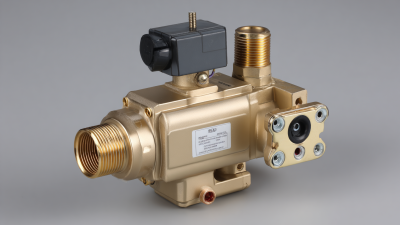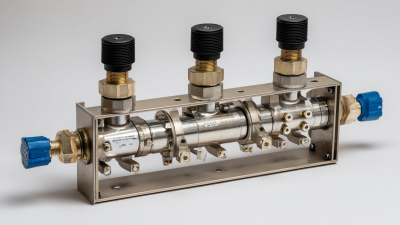Top Strategies for Maximizing Efficiency with Electric Valves in Industrial Applications
In the fast-evolving landscape of industrial automation, the integration of electric valves has emerged as a pivotal factor in enhancing operational efficiency. According to a report by MarketsandMarkets, the global electric valve market is projected to reach $8.56 billion by 2026, growing at a CAGR of 5.10% from 2021. This growth is driven by industries seeking reliable, precise control over fluid and gas flow, which is critical for optimizing processes and reducing operational costs. Electric valves offer superior performance compared to their traditional counterparts, providing benefits such as improved energy efficiency and reduced maintenance requirements. As industries strive to maximize productivity and minimize downtime, understanding the best strategies for leveraging electric valves becomes essential for achieving sustained competitive advantage. This article delves into key strategies that can help organizations harness the full potential of electric valves in their operations.

Understanding the Role of Electric Valves in Modern Industrial Processes
Electric valves play a pivotal role in modern industrial processes, serving as crucial components in automation and control systems. By utilizing an electric motor to operate the valve, these devices offer precise control over fluid flow, which is essential for maintaining optimal operating conditions. In industries ranging from manufacturing to oil and gas, the ability to adjust valve positions automatically can lead to significant enhancements in productivity and efficiency. Electric valves enable real-time monitoring and control, ensuring that systems operate within desired parameters and reducing the risk of errors caused by manual intervention.
Moreover, the integration of electric valves into industrial applications aligns with trending advancements in Industry 4.0, where smart technologies and IoT devices dominate. These valves can be equipped with sensors and connectivity features, facilitating data collection and predictive maintenance. This not only helps in minimizing downtime but also conserves energy and resources by optimizing operational processes. As industries continue to evolve, electric valves are becoming integral to achieving higher efficiency levels, demonstrating their vital role in shaping the future of industrial operations.
Key Benefits of Implementing Electric Valves for Operational Efficiency
 Electric valves have emerged as a pivotal component in enhancing operational efficiency across various industrial applications. One of the key benefits of implementing electric valves is their ability to offer precise control over fluid flow. Unlike traditional manual valves, electric valves can be integrated with advanced control systems that allow for real-time adjustments and optimizations. This level of precision helps maintain consistent operational parameters, reduces material waste, and minimizes the risk of equipment damage.
Electric valves have emerged as a pivotal component in enhancing operational efficiency across various industrial applications. One of the key benefits of implementing electric valves is their ability to offer precise control over fluid flow. Unlike traditional manual valves, electric valves can be integrated with advanced control systems that allow for real-time adjustments and optimizations. This level of precision helps maintain consistent operational parameters, reduces material waste, and minimizes the risk of equipment damage.
Additionally, electric valves significantly enhance responsiveness in industrial processes. With features such as fast actuation and network connectivity, these valves can react swiftly to changes in system demands. This adaptability not only boosts overall productivity but also enables facilities to respond promptly to unforeseen operational challenges. Moreover, the automation potential of electric valves contributes to reduced labor costs, as they require less manual intervention for monitoring and operation. The integration of electric valves thus streamlines workflows, leading to improved efficiency and reduced downtime in industrial settings.
Best Practices for Integrating Electric Valves into Existing Systems
Integrating electric valves into existing systems is a pivotal step in enhancing efficiency in industrial applications. To achieve seamless integration, it is crucial to assess the compatibility of the electric valves with current infrastructure. This includes examining the required power supply, signal types, and control systems to ensure that the new components can function cohesively with existing systems. Moreover, training personnel on the operation and maintenance of electric valves is essential, as it enhances overall performance and reduces the risk of downtime.
Another best practice involves utilizing advanced monitoring technologies to track the performance of electric valves in real-time. By implementing IoT solutions, companies can gather data on valve performance and system efficiency, allowing for timely adjustments and predictive maintenance. Additionally, incorporating such technologies promotes a proactive approach to any operational issues, leading to significant reductions in unexpected failures and maintenance costs. This data-driven method not only helps in maximizing efficiency but also supports companies in their journey towards sustainability in industrial processes.
Top Strategies for Maximizing Efficiency with Electric Valves in Industrial Applications
| Strategy | Description | Benefits | Implementation Tips |
|---|---|---|---|
| Regular Maintenance | Establish a routine maintenance schedule to inspect and service electric valves. | Increases lifespan, prevents unexpected failures, and ensures reliable operation. | Create a checklist for inspections and set reminders for service dates. |
| Proper Sizing | Select valves based on the specific flow requirements of the application. | Optimizes flow control and energy consumption, reducing costs. | Use flow calculation tools during the selection process to ensure accuracy. |
| Integration with Control Systems | Ensure electric valves are compatible with existing control systems for seamless operation. | Improves system responsiveness and operational efficiency. | Consult with system integrators to plan effective integration strategies. |
| Data Monitoring | Implement sensors to monitor valve performance and system parameters. | Provides real-time data for better decision-making and maintenance forecasting. | Utilize IoT platforms for data visualization and analytics. |
| Staff Training | Train staff on proper operation and troubleshooting of electric valves. | Reduces operational errors and enhances safety. | Organize regular training sessions and provide easy access to manuals. |
Advanced Technologies Enhancing Performance of Electric Valves
The advancement of technology has significantly transformed the performance of electric valves in industrial applications. With the integration of smart sensors and IoT capabilities, these valves are not just components but pivotal players in process automation. By utilizing real-time data analytics, industries can monitor the performance of electric valves, allowing for predictive maintenance and reducing downtime. This capability enhances operational efficiency and minimizes costs, proving vital in applications where precision and reliability are crucial.
Moreover, the implementation of advanced materials and design innovations has resulted in electric valves that are more robust and adaptable to harsh environments. These innovations enable them to withstand extreme temperatures and corrosive substances, ensuring longevity and reduced maintenance needs. Furthermore, advancements in control algorithms allow for smoother and more accurate valve operation, which is essential for maintaining optimal flow rates and system stability. As industries continue to evolve towards more automated systems, the role of electric valves, enhanced by cutting-edge technologies, will be indispensable in driving efficiency and performance.

Common Challenges and Solutions in Utilizing Electric Valves in Industry
In industrial applications, utilizing electric valves can significantly enhance operational efficiency, but challenges persist that need addressing for optimal performance. Common issues include the potential for methane emissions when using pneumatic systems. Recent field tests have shown that electric valve actuators provide a precise linear motion, making them a suitable alternative that not only maintains control but also reduces environmental impact. This advancement positions electric valves as a critical component in minimizing operational costs and meeting sustainability goals.
To maximize efficiency with electric valves, consider implementing predictive maintenance strategies. Regular monitoring of valve performance can help identify wear and tear before it becomes a significant issue. Additionally, ensure that operators are adequately trained on the technology to avoid improper usage that can lead to mechanical failures. Another tip is to evaluate existing control systems for compatibility with electric valve technology, as integrating modern automation solutions can streamline processes and enhance data collection for better decision-making.
Related Posts
-

Discover Top Quality Electric Valves from Leading Manufacturers in China
-

7 Effective Strategies for Choosing the Right Electric Valve
-

How to Select the Best Pneumatic Valve for Your Industrial Applications
-

7 Essential Benefits of Using High Pressure Ball Valves in Industrial Applications
-

Mastering the Basics of 3 Way Ball Valve Installation and Maintenance Guide
-

Unlocking Efficiency: Technical Specifications of the Best 3 Way Ball Valve and How to Optimize Its Use
